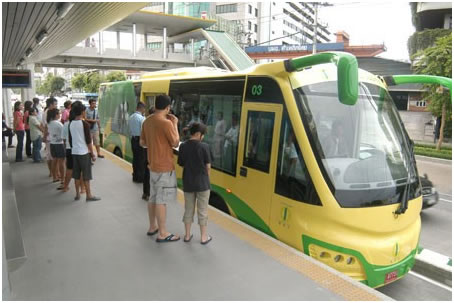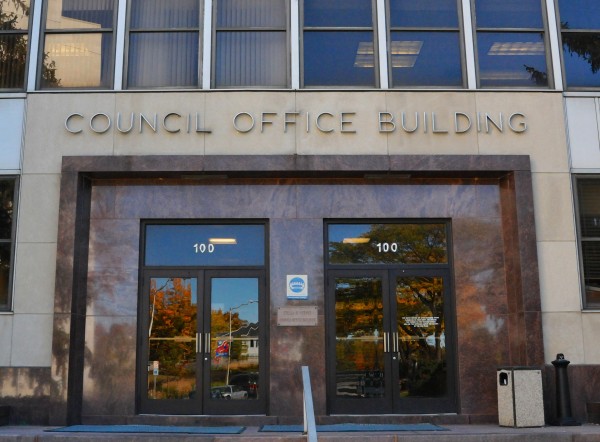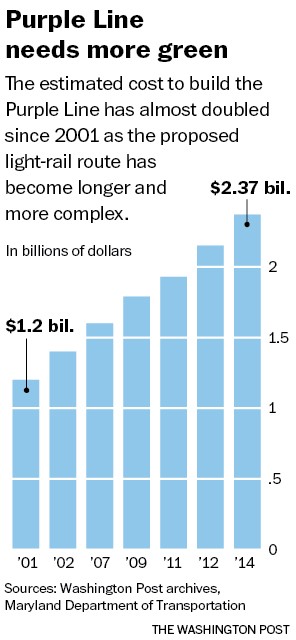
Bus-Rapid Transit
Only a few days after I wrote a post outlining County Executive Ike Leggett’s proposal to create an Independent Transit Authority (ITA) for Montgomery County, the state legislative bill towards that end was withdrawn at his request as it didn’t seem likely to pass.
While MCGEO’s Gino Renne would probably like to think that the bizarre circus he created around the bill’s hearing, analyzed yesterday (“Ready for His Closeup”), had a lot to do with it–and it didn’t help–ultimately many other factors played a far greater role in the decision not to move forward now.
Playing Captain Hindsight and analyzing what went wrong is sometimes a little frustrating to those involved. Still, analysis can serve as food for thought for next time, not a bad idea since Tom Street in Ike Leggett’s office told me that the County Executive hasn’t given up yet: “He is soliciting ideas and alternatives but still believes, absent hearing about anything better, that he has the right approach.”
The Process
At the hearing, there was much outrage expressed about the political process. Except that this is the normal process for how bills become laws. The General Assembly meets only for 90 days every year and a lot has to get done in the session. Late-filed bills occur in every session and the hearing was moved to Rockville from Annapolis to make public input easier.
Many often complain that the state legislative delegation doesn’t work well with the County government. In this case, the delegation responded quickly to a request from the County Executive, who was just reelected to a third term, to aid with a top priority.
Nonetheless, the Executive needed to think more about the unofficial process (i.e. do more to get his ducks in a row in advance). Though many people testified in favor of the bill, they were for the bill rather than FOR the bill.
If there were clarion calls from the organizations that should emphatically favor this legislation (e.g. Action Committee for Transit), I sure didn’t hear them. More consultation with key players probably would have served the Executive well.
Executive Leadership
County Executive Ike Leggett deserves credit for getting the discussion started on an ITA. While not without drawbacks, it provides a means for Montgomery to move forward in a meaningful way on its transportation priorities and to make sure that tax dollars for the purpose stay in Montgomery.
Nonetheless, the WaPo editorial lauding the County Executive for his leadership doesn’t mention that he walked out of the hearing early without talking to any of his constituents as he departed. County Executive Leggett normally excels at listening–a key part of the job–so I was surprised to hear this. If he wants something of this magnitude that will inevitably engender some controversy, he needs to be willing to stand his ground and argue for it.
To Do What?
More needed to be done to outline specifically the intended purpose of the ITA with various ideas floated. While the County Executive proposed this with something in mind, it was not made sufficiently clear to the public.
He needs to outline for the community what he wants to do. In particular, he should explain that we need to build the Corridor Cities Transitway (CCT)–already advanced into the design phase–and one other BRT line in the network approved in the County Master Plan as a demonstration project before doing the rest of the planned system.
The CCT is widely supported and will give the County a real economic boost. As Tom Street explained: “The CCT has more documented job creation potential than any other proposed transit project in the County. It is a very high priority for the Executive.”
Additionally, the Viers Mill BRT route provokes less controversy than others as most of it can be built in the median. The operation of one line will likely help answer questions many residents have regarding a mode of transit new to them.
The Business Community
The business community is hesitant to get fully behind an ITA because, like everyone else, they don’t want to pay and balk when asked to trust the tender mercies of the County Council on the amount. But business would be more supportive of a finite amount utilized to build projects that it wants.
One potential solution would be to create special tax districts geared toward capturing revenue from commercial landowners who stand to benefit tremendously from this project to provide the capital needed for construction but not operating costs. The county already has the authority to do this without an ITA.
These tax districts would shift capital costs away from residents, which they would like, towards commercial beneficiaries. Capping the costs at capital expenditures would reassure business, however, that they are not on the hook for unlimited amounts.
Residents and the Charter Limit
Montgomery County currently charges the highest property tax and highest income tax legally permitted. Residents are naturally suspicious when asked to pay more. Their suspicions rise even further when shifting expenses from the current budget to the ITA would allow more spending in other areas than possible under the current Charter limit.
The County Executive will never assuage all concerns. Some will oppose all taxes and just don’t want any BRT lines. But there are steps he could take to build greater trust with the public. Making clearer the purpose of the ITA in conjunction with the County Council would be a good start.
Additionally, any tax expenditures shifted over from the budget to the ITA–for example, if the ITA managed the Ride-On system– should still continue to count towards the Charter limit. This should reduce concern that the ITA is simply a ruse to raise spending on non-transportation measures.
The taxes designated for the ITA should also focus on operating rather than capital expenditures. If special tax districts targeted at business pay for most of the capital costs, it is easier to make the case that we should then pay to maintain this infrastructure. It would also reduce the new taxes required from residents.
County Council Leadership
The Executive and the County Council could have worked more closely together with the Council signally support by vocally backing a proposal earlier. This time, the Council appeared to lead from behind and to distance themselves from the ITA proposal.
Council President George Leventhal projects himself as a transit leader despite his tepid support for BRT. But he missed a real opportunity to take a leadership role here in crafting a proposal and building support. The Council President should take the lead with County Executive Leggett to present a united proposal.
Both could then claim credit for having moved Montgomery off the dime on public transit. The Council has a key role to play here due its extensive authority and because its commitments are critical to establishing support from key players.
Alternatively, the Council could find the means to construct the Viers Mill BRT line within its existing budget as an initial more affordable step toward building a larger system.








